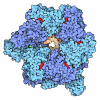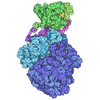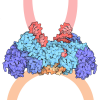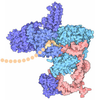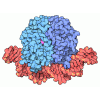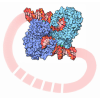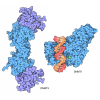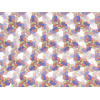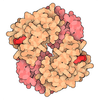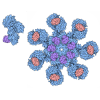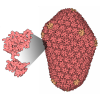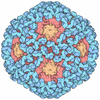[English] 日本語
 Yorodumi
Yorodumi- PDB-7lyb: Cryo-EM structure of the human nucleosome core particle in comple... -
+ Open data
Open data
- Basic information
Basic information
| Entry | Database: PDB / ID: 7lyb | ||||||||||||
|---|---|---|---|---|---|---|---|---|---|---|---|---|---|
| Title | Cryo-EM structure of the human nucleosome core particle in complex with BRCA1-BARD1-UbcH5c | ||||||||||||
 Components Components |
| ||||||||||||
 Keywords Keywords | STRUCTURAL PROTEIN/DNA / Nucleosome core particle / chromatin / BRCA1 / BARD1 / UbcH5c / DNA repair / DNA double-strand break / Homologous recombination / 53BP1 / STRUCTURAL PROTEIN-DNA complex | ||||||||||||
| Function / homology |  Function and homology information Function and homology informationnegative regulation of mRNA 3'-end processing / histone H2AK127 ubiquitin ligase activity / histone H2AK129 ubiquitin ligase activity / Defective DNA double strand break response due to BRCA1 loss of function / Defective DNA double strand break response due to BARD1 loss of function / BRCA1-BARD1 complex / BRCA1-B complex / BRCA1-A complex / BRCA1-C complex / negative regulation of centriole replication ...negative regulation of mRNA 3'-end processing / histone H2AK127 ubiquitin ligase activity / histone H2AK129 ubiquitin ligase activity / Defective DNA double strand break response due to BRCA1 loss of function / Defective DNA double strand break response due to BARD1 loss of function / BRCA1-BARD1 complex / BRCA1-B complex / BRCA1-A complex / BRCA1-C complex / negative regulation of centriole replication / sex-chromosome dosage compensation / random inactivation of X chromosome / ubiquitin-modified histone reader activity / chordate embryonic development / nuclear ubiquitin ligase complex / cellular response to indole-3-methanol / gamma-tubulin ring complex / negative regulation of intracellular estrogen receptor signaling pathway / DNA strand resection involved in replication fork processing / negative regulation of fatty acid biosynthetic process / homologous recombination / Regulation of MITF-M-dependent genes involved in DNA replication, damage repair and senescence / tissue homeostasis / Signaling by BMP / protein K6-linked ubiquitination / regulation of phosphorylation / (E3-independent) E2 ubiquitin-conjugating enzyme / lateral element / regulation of DNA damage checkpoint / Impaired BRCA2 binding to PALB2 / XY body / mitotic G2/M transition checkpoint / negative regulation of protein export from nucleus / protein K11-linked ubiquitination / RNA polymerase binding / DNA damage tolerance / DNA repair complex / centrosome cycle / positive regulation of protein targeting to mitochondrion / Homologous DNA Pairing and Strand Exchange / Defective homologous recombination repair (HRR) due to BRCA1 loss of function / Defective HDR through Homologous Recombination Repair (HRR) due to PALB2 loss of BRCA1 binding function / Defective HDR through Homologous Recombination Repair (HRR) due to PALB2 loss of BRCA2/RAD51/RAD51C binding function / Resolution of D-loop Structures through Synthesis-Dependent Strand Annealing (SDSA) / Resolution of D-loop Structures through Holliday Junction Intermediates / HDR through Single Strand Annealing (SSA) / intracellular membraneless organelle / E2 ubiquitin-conjugating enzyme / response to ionizing radiation / negative regulation of gene expression via chromosomal CpG island methylation / Impaired BRCA2 binding to RAD51 / Transcriptional Regulation by E2F6 / mitotic G2 DNA damage checkpoint signaling / negative regulation of cell cycle / ubiquitin conjugating enzyme activity / negative regulation of reactive oxygen species metabolic process / positive regulation of vascular endothelial growth factor production / Presynaptic phase of homologous DNA pairing and strand exchange / protein monoubiquitination / negative regulation of BMP signaling pathway / ubiquitin ligase complex / negative regulation of tumor necrosis factor-mediated signaling pathway / protein K48-linked ubiquitination / SUMOylation of DNA damage response and repair proteins / negative regulation of extrinsic apoptotic signaling pathway via death domain receptors / regulation of DNA repair / negative regulation of megakaryocyte differentiation / protein autoubiquitination / protein localization to CENP-A containing chromatin / Chromatin modifying enzymes / Replacement of protamines by nucleosomes in the male pronucleus / CENP-A containing nucleosome / Packaging Of Telomere Ends / Recognition and association of DNA glycosylase with site containing an affected purine / Cleavage of the damaged purine / Deposition of new CENPA-containing nucleosomes at the centromere / Recognition and association of DNA glycosylase with site containing an affected pyrimidine / Cleavage of the damaged pyrimidine / tubulin binding / telomere organization / Interleukin-7 signaling / Inhibition of DNA recombination at telomere / RNA Polymerase I Promoter Opening / Meiotic synapsis / positive regulation of DNA repair / Assembly of the ORC complex at the origin of replication / TICAM1, RIP1-mediated IKK complex recruitment / SUMOylation of chromatin organization proteins / Regulation of endogenous retroelements by the Human Silencing Hub (HUSH) complex / epigenetic regulation of gene expression / DNA methylation / Condensation of Prophase Chromosomes / IKK complex recruitment mediated by RIP1 / Chromatin modifications during the maternal to zygotic transition (MZT) / SIRT1 negatively regulates rRNA expression / HCMV Late Events / PINK1-PRKN Mediated Mitophagy / innate immune response in mucosa / ERCC6 (CSB) and EHMT2 (G9a) positively regulate rRNA expression / PRC2 methylates histones and DNA Similarity search - Function | ||||||||||||
| Biological species |  Homo sapiens (human) Homo sapiens (human) | ||||||||||||
| Method | ELECTRON MICROSCOPY / single particle reconstruction / cryo EM / Resolution: 3.28 Å | ||||||||||||
 Authors Authors | Hu, Q. / Botuyan, M.V. / Zhao, D. / Cui, D. / Mer, E. / Mer, G. | ||||||||||||
| Funding support |  United States, 3items United States, 3items
| ||||||||||||
 Citation Citation |  Journal: Nature / Year: 2021 Journal: Nature / Year: 2021Title: Mechanisms of BRCA1-BARD1 nucleosome recognition and ubiquitylation. Authors: Qi Hu / Maria Victoria Botuyan / Debiao Zhao / Gaofeng Cui / Elie Mer / Georges Mer /  Abstract: The BRCA1-BARD1 tumour suppressor is an E3 ubiquitin ligase necessary for the repair of DNA double-strand breaks by homologous recombination. The BRCA1-BARD1 complex localizes to damaged chromatin ...The BRCA1-BARD1 tumour suppressor is an E3 ubiquitin ligase necessary for the repair of DNA double-strand breaks by homologous recombination. The BRCA1-BARD1 complex localizes to damaged chromatin after DNA replication and catalyses the ubiquitylation of histone H2A and other cellular targets. The molecular bases for the recruitment to double-strand breaks and target recognition of BRCA1-BARD1 remain unknown. Here we use cryo-electron microscopy to show that the ankyrin repeat and tandem BRCT domains in BARD1 adopt a compact fold and bind to nucleosomal histones, DNA and monoubiquitin attached to H2A amino-terminal K13 or K15, two signals known to be specific for double-strand breaks. We further show that RING domains in BRCA1-BARD1 orient an E2 ubiquitin-conjugating enzyme atop the nucleosome in a dynamic conformation, primed for ubiquitin transfer to the flexible carboxy-terminal tails of H2A and variant H2AX. Our work reveals a regulatory crosstalk in which recognition of monoubiquitin by BRCA1-BARD1 at the N terminus of H2A blocks the formation of polyubiquitin chains and cooperatively promotes ubiquitylation at the C terminus of H2A. These findings elucidate the mechanisms of BRCA1-BARD1 chromatin recruitment and ubiquitylation specificity, highlight key functions of BARD1 in both processes and explain how BRCA1-BARD1 promotes homologous recombination by opposing the DNA repair protein 53BP1 in post-replicative chromatin. These data provide a structural framework to evaluate BARD1 variants and help to identify mutations that drive the development of cancer. | ||||||||||||
| History |
|
- Structure visualization
Structure visualization
| Movie |
 Movie viewer Movie viewer |
|---|---|
| Structure viewer | Molecule:  Molmil Molmil Jmol/JSmol Jmol/JSmol |
- Downloads & links
Downloads & links
- Download
Download
| PDBx/mmCIF format |  7lyb.cif.gz 7lyb.cif.gz | 394.6 KB | Display |  PDBx/mmCIF format PDBx/mmCIF format |
|---|---|---|---|---|
| PDB format |  pdb7lyb.ent.gz pdb7lyb.ent.gz | 296.7 KB | Display |  PDB format PDB format |
| PDBx/mmJSON format |  7lyb.json.gz 7lyb.json.gz | Tree view |  PDBx/mmJSON format PDBx/mmJSON format | |
| Others |  Other downloads Other downloads |
-Validation report
| Summary document |  7lyb_validation.pdf.gz 7lyb_validation.pdf.gz | 1.6 MB | Display |  wwPDB validaton report wwPDB validaton report |
|---|---|---|---|---|
| Full document |  7lyb_full_validation.pdf.gz 7lyb_full_validation.pdf.gz | 1.6 MB | Display | |
| Data in XML |  7lyb_validation.xml.gz 7lyb_validation.xml.gz | 44 KB | Display | |
| Data in CIF |  7lyb_validation.cif.gz 7lyb_validation.cif.gz | 68.8 KB | Display | |
| Arichive directory |  https://data.pdbj.org/pub/pdb/validation_reports/ly/7lyb https://data.pdbj.org/pub/pdb/validation_reports/ly/7lyb ftp://data.pdbj.org/pub/pdb/validation_reports/ly/7lyb ftp://data.pdbj.org/pub/pdb/validation_reports/ly/7lyb | HTTPS FTP |
-Related structure data
| Related structure data |  23591MC  7lyaC  7lycC M: map data used to model this data C: citing same article ( |
|---|---|
| Similar structure data |
- Links
Links
- Assembly
Assembly
| Deposited unit | 
|
|---|---|
| 1 |
|
- Components
Components
-Protein , 7 types, 11 molecules AEBFDHMPNCG
| #1: Protein | Mass: 15786.534 Da / Num. of mol.: 2 Source method: isolated from a genetically manipulated source Source: (gene. exp.)  Homo sapiens (human) Homo sapiens (human)Gene: H3C1, H3FA, HIST1H3A, H3C2, H3FL, HIST1H3B, H3C3, H3FC HIST1H3C, H3C4, H3FB, HIST1H3D, H3C6, H3FD, HIST1H3E, H3C7, H3FI, HIST1H3F, H3C8, H3FH, HIST1H3G, H3C10, H3FK, HIST1H3H, H3C11, H3FF, ...Gene: H3C1, H3FA, HIST1H3A, H3C2, H3FL, HIST1H3B, H3C3, H3FC HIST1H3C, H3C4, H3FB, HIST1H3D, H3C6, H3FD, HIST1H3E, H3C7, H3FI, HIST1H3F, H3C8, H3FH, HIST1H3G, H3C10, H3FK, HIST1H3H, H3C11, H3FF, HIST1H3I, H3C12, H3FJ, HIST1H3J Production host:  #2: Protein | Mass: 11743.792 Da / Num. of mol.: 2 Source method: isolated from a genetically manipulated source Source: (gene. exp.)  Homo sapiens (human) Homo sapiens (human)Gene: H4C1, H4/A, H4FA, HIST1H4A, H4C2, H4/I, H4FI, HIST1H4B, H4C3, H4/G, H4FG, HIST1H4C, H4C4, H4/B, H4FB, HIST1H4D, H4C5, H4/J, H4FJ, HIST1H4E, H4C6, H4/C, H4FC, HIST1H4F, H4C8, H4/H, H4FH, ...Gene: H4C1, H4/A, H4FA, HIST1H4A, H4C2, H4/I, H4FI, HIST1H4B, H4C3, H4/G, H4FG, HIST1H4C, H4C4, H4/B, H4FB, HIST1H4D, H4C5, H4/J, H4FJ, HIST1H4E, H4C6, H4/C, H4FC, HIST1H4F, H4C8, H4/H, H4FH, HIST1H4H, H4C9, H4/M, H4FM, HIST1H4I, H4C11, H4/E, H4FE, HIST1H4J, H4C12, H4/D, H4FD, HIST1H4K, H4C13, H4/K, H4FK, HIST1H4L, H4C14, H4/N, H4F2, H4FN, HIST2H4, HIST2H4A, H4C15, H4/O, H4FO, HIST2H4B, H4-16, HIST4H4 Production host:  #3: Protein | Mass: 13930.181 Da / Num. of mol.: 2 Source method: isolated from a genetically manipulated source Source: (gene. exp.)  Homo sapiens (human) / Gene: H2BC11, H2BFR, HIST1H2BJ / Production host: Homo sapiens (human) / Gene: H2BC11, H2BFR, HIST1H2BJ / Production host:  #6: Protein | | Mass: 13053.065 Da / Num. of mol.: 1 / Fragment: RING domain (UNP residues 1-100) Source method: isolated from a genetically manipulated source Source: (gene. exp.)  Homo sapiens (human) / Gene: BRCA1, RNF53 / Production host: Homo sapiens (human) / Gene: BRCA1, RNF53 / Production host:  References: UniProt: P38398, RING-type E3 ubiquitin transferase #7: Protein | | Mass: 17869.113 Da / Num. of mol.: 1 Source method: isolated from a genetically manipulated source Source: (gene. exp.)  Homo sapiens (human) / Gene: UBE2D3, UBC5C, UBCH5C / Production host: Homo sapiens (human) / Gene: UBE2D3, UBC5C, UBCH5C / Production host:  References: UniProt: P61077, E2 ubiquitin-conjugating enzyme, (E3-independent) E2 ubiquitin-conjugating enzyme #8: Protein | | Mass: 10906.617 Da / Num. of mol.: 1 / Fragment: RING domain (UNP residues 26-122) Source method: isolated from a genetically manipulated source Source: (gene. exp.)  Homo sapiens (human) / Gene: BARD1 / Production host: Homo sapiens (human) / Gene: BARD1 / Production host:  References: UniProt: Q99728, RING-type E3 ubiquitin transferase #9: Protein | Mass: 13034.193 Da / Num. of mol.: 2 Source method: isolated from a genetically manipulated source Source: (gene. exp.)  Homo sapiens (human) / Gene: H2AC4, H2AFM, HIST1H2AB, H2AC8, H2AFA, HIST1H2AE / Production host: Homo sapiens (human) / Gene: H2AC4, H2AFM, HIST1H2AB, H2AC8, H2AFA, HIST1H2AE / Production host:  |
|---|
-DNA chain , 2 types, 2 molecules IJ
| #4: DNA chain | Mass: 45138.770 Da / Num. of mol.: 1 Source method: isolated from a genetically manipulated source Source: (gene. exp.)  Homo sapiens (human) / Production host: Homo sapiens (human) / Production host:  |
|---|---|
| #5: DNA chain | Mass: 45610.043 Da / Num. of mol.: 1 Source method: isolated from a genetically manipulated source Source: (gene. exp.)  Homo sapiens (human) / Production host: Homo sapiens (human) / Production host:  |
-Non-polymers , 1 types, 4 molecules 
| #10: Chemical | ChemComp-ZN / |
|---|
-Details
| Has ligand of interest | N |
|---|---|
| Has protein modification | Y |
-Experimental details
-Experiment
| Experiment | Method: ELECTRON MICROSCOPY |
|---|---|
| EM experiment | Aggregation state: PARTICLE / 3D reconstruction method: single particle reconstruction |
- Sample preparation
Sample preparation
| Component | Name: Human nucleosome core particle in complex with BRCA1-BARD1-UbcH5c Type: COMPLEX / Entity ID: #1-#9 / Source: RECOMBINANT |
|---|---|
| Molecular weight | Units: MEGADALTONS / Experimental value: YES |
| Source (natural) | Organism:  Homo sapiens (human) Homo sapiens (human) |
| Source (recombinant) | Organism:  |
| Buffer solution | pH: 7.5 |
| Specimen | Conc.: 0.3 mg/ml / Embedding applied: NO / Shadowing applied: NO / Staining applied: NO / Vitrification applied: YES / Details: 10 mM HEPES, 100 mM NaCl, 1 mM DTT, pH 7.5 |
| Specimen support | Grid material: COPPER / Grid mesh size: 300 divisions/in. / Grid type: Quantifoil R1.2/1.3 |
| Vitrification | Instrument: FEI VITROBOT MARK IV / Cryogen name: ETHANE / Humidity: 100 % / Chamber temperature: 277 K |
- Electron microscopy imaging
Electron microscopy imaging
| Experimental equipment |  Model: Titan Krios / Image courtesy: FEI Company |
|---|---|
| Microscopy | Model: FEI TITAN KRIOS |
| Electron gun | Electron source:  FIELD EMISSION GUN / Accelerating voltage: 300 kV / Illumination mode: FLOOD BEAM FIELD EMISSION GUN / Accelerating voltage: 300 kV / Illumination mode: FLOOD BEAM |
| Electron lens | Mode: BRIGHT FIELD / Nominal magnification: 22500 X / Cs: 2.7 mm |
| Specimen holder | Specimen holder model: FEI TITAN KRIOS AUTOGRID HOLDER |
| Image recording | Electron dose: 1 e/Å2 / Film or detector model: GATAN K3 BIOQUANTUM (6k x 4k) / Num. of grids imaged: 1 / Num. of real images: 5490 |
- Processing
Processing
| Software | Name: PHENIX / Version: 1.18.2_3874: / Classification: refinement | ||||||||||||||||||||||||||||||||||||||||||||
|---|---|---|---|---|---|---|---|---|---|---|---|---|---|---|---|---|---|---|---|---|---|---|---|---|---|---|---|---|---|---|---|---|---|---|---|---|---|---|---|---|---|---|---|---|---|
| EM software |
| ||||||||||||||||||||||||||||||||||||||||||||
| CTF correction | Type: PHASE FLIPPING AND AMPLITUDE CORRECTION | ||||||||||||||||||||||||||||||||||||||||||||
| Particle selection | Num. of particles selected: 6380972 | ||||||||||||||||||||||||||||||||||||||||||||
| Symmetry | Point symmetry: C1 (asymmetric) | ||||||||||||||||||||||||||||||||||||||||||||
| 3D reconstruction | Resolution: 3.28 Å / Resolution method: FSC 0.143 CUT-OFF / Num. of particles: 74575 / Symmetry type: POINT | ||||||||||||||||||||||||||||||||||||||||||||
| Atomic model building | Protocol: RIGID BODY FIT / Space: REAL | ||||||||||||||||||||||||||||||||||||||||||||
| Atomic model building |
| ||||||||||||||||||||||||||||||||||||||||||||
| Refine LS restraints |
|
 Movie
Movie Controller
Controller











 PDBj
PDBj
